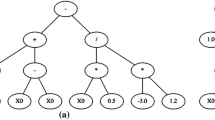Abstract
The Time-delay Added Evolutionary Forecasting (TAEF) approach is a new method for time series prediction that performs an evolutionary search for the minimum number of dimensions necessary to represent the underlying information that generates the time series. The methodology proposed is inspired in Takens theorem and consists of an intelligent hybrid model composed of an artificial neural network combined with a modified genetic algorithm. Initially, the TAEF method finds the best fitted model to forecast the series and then performs a behavioral statistical test in order to adjust time phase distortions that may appear in the representation of some series. An experimental investigation conducted with relevant time series show the robustness of the method through a comparison, according to several performance measures, to previous results found in the literature and those obtained with more traditional methods.
Similar content being viewed by others
Explore related subjects
Discover the latest articles, news and stories from top researchers in related subjects.References
Andreou AS, Georgopolulos EF, Likothanassis SD (2002) Exchange-rates forecasting: a hybrid algorithm based on genetically optimized adaptive neural networks. Comput Econ 20(3): 191–210
Battiti R (1992) One step secant conjugate gradient. Neural Comput 4: 141–166
Binner J, Kendall G, Gazely A (2004) Evolving neural networks with evolutionary strategies: a new application to divisia money. Adv Econom 19: 127–143
Box GEP, Jenkins GM, Reinsel GC (1994) Time series analysis: forecasting and control. Prentice Hall, New Jersey
Chang BR, Tsai HF (2007) Composite of adaptive support vector regression and nonlinear conditional heteroscedasticity tuned by quantum minimization for forecast. Appl Intell 27: 277–289
Clementes MP, Hendry DF (1993) On the limitations of comparing mean squared forecast erros. J Forecasting 12(8): 617–637
Cottrell M, Girard B, Girard Y, Mangeas M, Muller C (1995) Neural modeling for time series: a statistical stepwise method for weight elimination. IEEE Trans Neural Networks 6(6):1355–1364. doi:10.1109/72.471372
Eiben AE, Smith JE (2003) Introduction to evolutionary computing. Natural computing series. Springer, Berlin
Goldberg DE (1989) Genetic algorithms in search, optimization, and machine learning. Addison-Wesley
Haykins S (1998) Neural networks: a comprehensive foundation, 2nd edn. Princete Hall
Hocevar M, S̆irok B, Blagojevic B (2005) Prediction of cavitation vortex dynamics in the draft tube of a francis turbine using radial basis neural networks. Neural Comput Appl 14(3): 229–234
Islan MM, Yao X, Muraz K (2003) A construtive algorithm for training cooperative neural networks ensembles. IEEE Trans Neural Networks 14(4): 820–834
Kantz H, Schreiber T (2003) Nonlinear time series analysis, 2nd edn. Cambridge University Press, New York, NY, USA
Khotanzad A, Elragal H, Lu TL (2000) Combination of artificial neural-network forecasters for prediction of natural gas consumption. IEEE Trans Neural Networks 11(2):464–473. doi:10.1109/72.839015
Leung FHF, Lam HK, Ling SH, Tam PKS (2003) Tuning of the structure and parametrs of the neural network using an improved genetic algorithm. IEEE Trans Neural Networks 14(1): 79–88
Liu JTTJHCTK (2006) Tuning the structure and parameters of a neural network by using hybrid taguchi-genetic algorithm. IEEE Trans Neural Networks 17(1):69–80. doi:10.1109/TNN.2005.860885
Matilla-Garcfa M, Argnello C (2005) A hybrid approach based on neural networks and genetic algorithms to the study of profitability in the Spanish stock market. Appl Econ Lett 12(5): 303–308
Miller DA, Arquello R, Greenwood GW (2004) Evolving artificial neural ntwork structures: experimental results for biologivally inspired adaptive mutations. In: Proceedings of CEC2004—congress on evolutionary computation, vol 2, pp 2114–2119
Mills TC (2003) The econometric modelling of financial time series. Cambridge University Press, Cambridge
Moller MF (1993) A scaled conjugate gradient algorithm for fast supervised learning. Neural Networks 6: 525–533
Mor JJ (1977) The Levenberg–Marquardt algorithm: implementation and theory. In: Proceedings of Springer-Verlag in numerical analysis (Lecture notes in mathematics), pp 105–116
Myhre TC (1992) Financial forecasting at martin marietta energy systems, inc. J Busi Forecasting Methods Syst 11(1): 28–30
Pi H, Peterson C (1994) Finding the embedding dimension and variable dependences in time series. Neural Comput 6: 509–520
Preminger A, Franck R (2007) Forecasting exchange rates: a robust regression approach. Int J Forecasting 23(1): 71–84
Reidmiller M, Braun H (1993) A direct adaptive method for faster backpropagation learning: the rprop algorithm. In: Proceedings of the IEEE international conference on neural networks (ICNN), San Francisco, pp 586–591
Sitte R, Sitte J (2002) Neural networks approach to the random walk dilemma of financial time series. Appl Intell 16(3): 163–171
Stanley KO, Miikkulainen R (2002) Evolving neral networks though augmenting topologies. Evol Comput 10(2): 99–127
Takens F (1980) Detecting strange attractor in turbulence. In: Dold A, Eckmann B (eds) Dynamical systems and turbulence, Lecture notes in mathematics, vol 898, pp 366–381. Springer-Verlag, New York
Teru N, Dijk HKV (2002) Combined forecasts form linear and nonlinear time series models. Int J Forecasting 18: 421–438
Tome JAB, Carvalho JP (2005) Market index prediction using fuzzy boolean nets. In: Hybrid Intelligent Systems, 2005. (HIS ’05) fifth international conference on 5 pp. doi:10.1109/ICHIS.2005.71
Wang Y, Huang GB, Saratchandran P, Sundararajan N (2005) Time series study of ggap-rbf network: prediction of Nasdaq stock and nitrate contamination of drinking water. In: Proceedings of international joint conference on neural networks, IEEE, Montreal, Canada, pp 3127–3132
Yao X (1999) Evolving artificial neural networks. Proc IEEE 87(9): 1423–1447
Zhang GP, Kline D (2007) Quarterly time-series forecasting with neural networks. IEEE Trans Neural Networks 18(6):1800–1814. doi:10.1109/TNN.2007.896859
Zhang G, Patuwo BE, Hu MY (1998) Forecasting with artificial neural networks: the state of the art. Int J Forecasting 14: 35–62
Author information
Authors and Affiliations
Corresponding author
Rights and permissions
About this article
Cite this article
Ferreira, T.A.E., Vasconcelos, G.C. & Adeodato, P.J.L. A New Intelligent System Methodology for Time Series Forecasting with Artificial Neural Networks. Neural Process Lett 28, 113–129 (2008). https://doi.org/10.1007/s11063-008-9085-x
Received:
Accepted:
Published:
Issue Date:
DOI: https://doi.org/10.1007/s11063-008-9085-x




